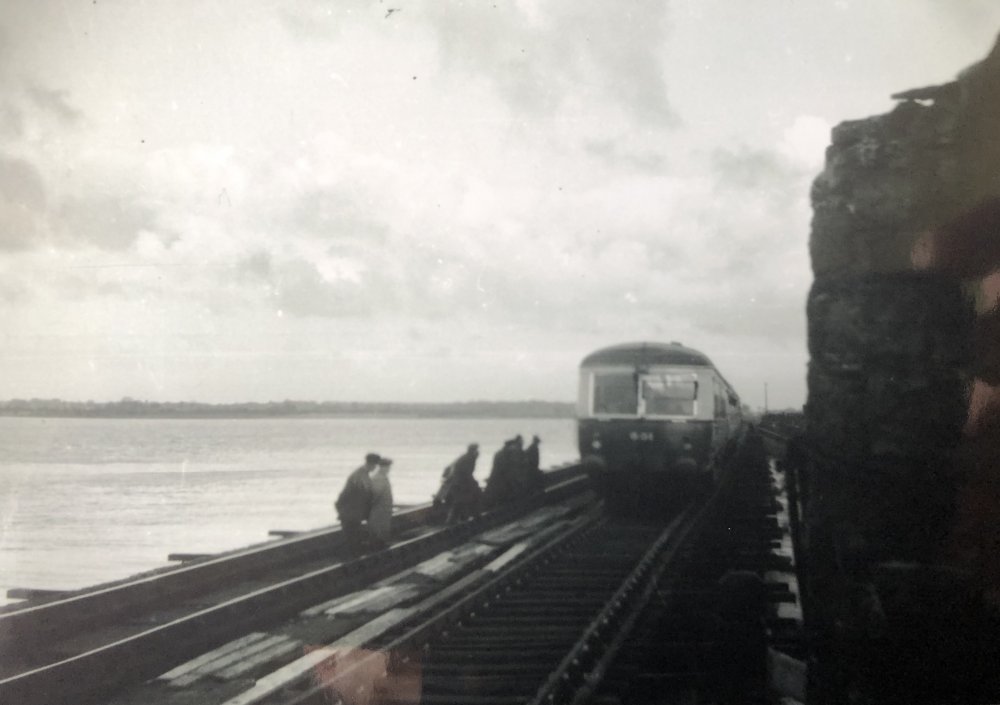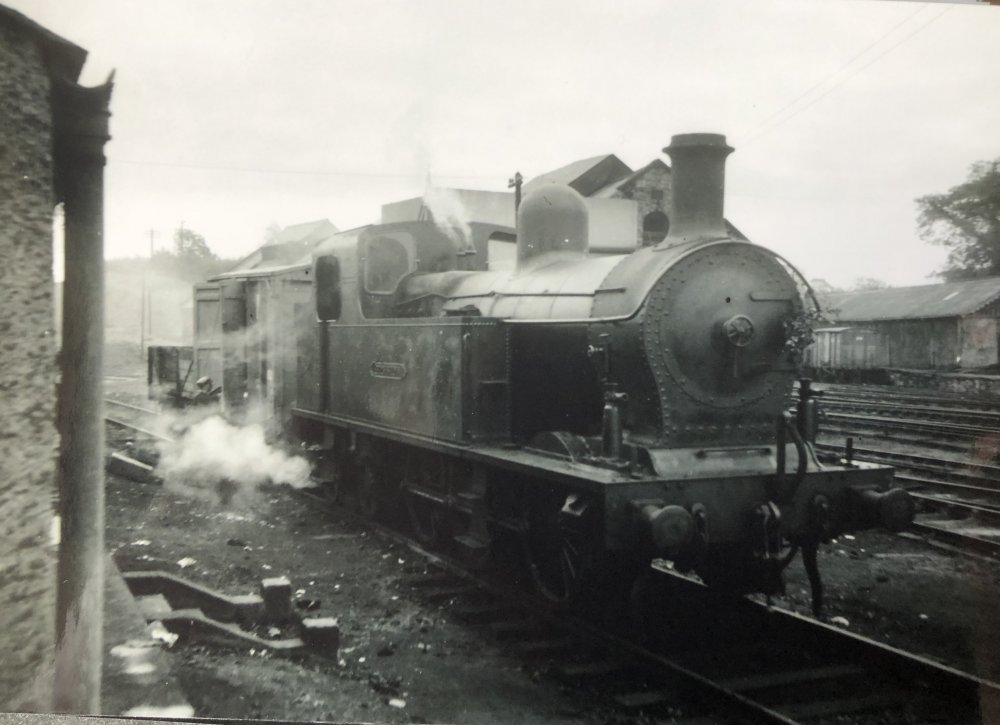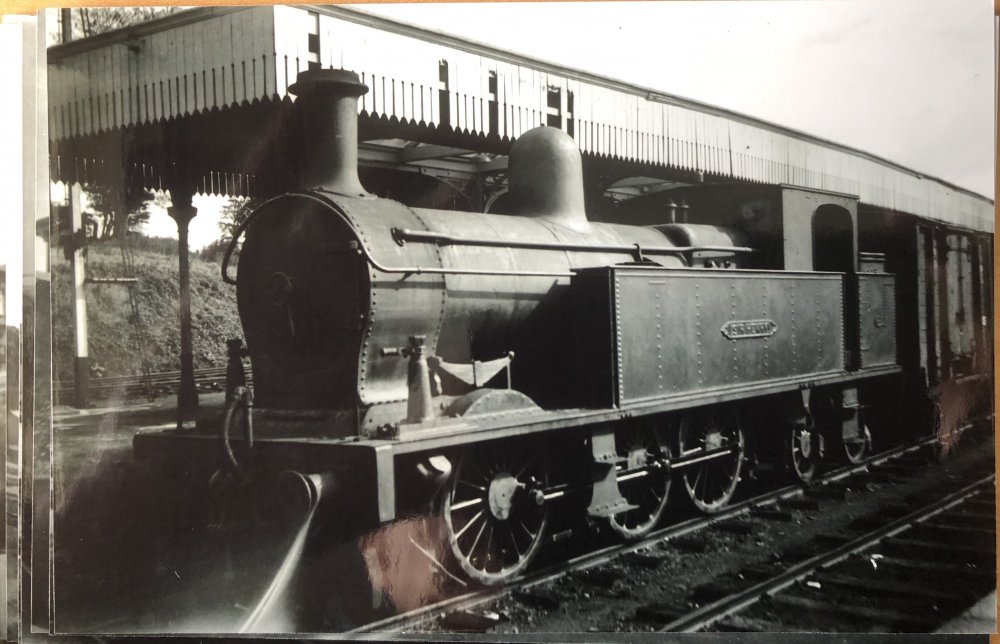-
Posts
15,862 -
Joined
-
Last visited
-
Days Won
393
Content Type
Profiles
Forums
Events
Gallery
Everything posted by jhb171achill
-
Ah, I was imagining you only had a very small space. You'll pack in a full terminus station on that size of board.
-
Which photo? I think I know what you're looking at but can you confirm....
- 309 replies
-
- mgwr
- 21mm gauge
-
(and 1 more)
Tagged with:
-
The A and C class were all cream inside. 121s were very light grey as were any 141s I was ever in. I don't remember what B101s were like inside as I only ever had one footplate ride in one. I have pics of the inside of a C somewhere, but I will have to search. If and when I come across them I will post them. I have a notion that the very oldest ones, the B113 duo, had cream upper and mid brown lower, like the cab of a steam engine, but again I would have to do some considerable delving! The G class were light grey lower, cream upper, as at Downpatrick, as far as I remember. E class - I'm not sure, but the DCDR could help - I think light grey. Again, I've a photo SOMEwhere!
-
Imahilus, here’s a suggestion. You want it small, dock setting and shunting-orientated. 1. Sea (harbour wall) 2. Sidings set in concrete or cobblestones on the quayside, for bringing wagons alongside unloading ships. 3. Loco shed for dock shunting loco? 4. Siding into some sort of small warehouse (a different / additional type of traffic?) 5. Run round loop. 6. Platform road. 7. A platform - could be short passenger platform to allow, say, a two-car railcar set to shuttle back and forth, or a goods platform with warehouse. 8. Line disappears through archway or tunnel mouth (like Cork) to go to / from a simple fiddle yard.
-
Brilliant! I was there for a month or so, and I learned it back then, though I've forgotten most now. It's a surprisingly easy language to learn, and pronunciation is easy. Good for when you wanted to say "I would like to see round the steam engine shed. Would you like some European cigarettes?"..... Anyway, I'm off topic...
-
You're the only other person I've ever come across who knows a few words of Bahasa Indonesia. Ada dimana kereta api? I even had a name picked for the layout based on a rural station on the south line - Gunung Merapi ("Fire Mountain"), after the well-known local volcano of that name, which two weeks after I was there destroyed the local rice economy completely by spewing a two-foot-deep layer of pumice and ash all over the surrounding countryside after it blew its top for the first time in many years! That was 1980; since then it has bubbled and smouldered a bit now and again.
-
Having an interest in Indonesian railways, I often thought of doing a small layout, believe it not, with a few of these on a Surabaya - Jogjakarta "main line". where a very similar-looking Japanese design hurried express passenger trains along back in the day. If a German class 52 could be had in that scale too, it wouldn't be unlike the PJKA's D52 class... Alas, not to be.
-
When were the Class 121's re-engined?
jhb171achill replied to irishthump's question in Questions & Answers
Referring to the ITG's 2004 guide, the following information may be of use. As built, the 121s all had the GM 8-567CR engine. Those changed, which don't seem to be all of them, are as follows. In this case, the replacements are: A = GM 8-B645E B = GM 8-567CR All 835RPM, all 950 HP. I have listed below the details; in the absence of an "A" or a "B", it may be assumed that they had their original engine until any swops took place with ex-"C" classes, and 141s or 181s. "ST" = Stopped - actual official withdrawal could come up to sixteen years later, or a month later - but for the modeller, the last date they were seen out and about is more relevant. "SC" = Scrapped at Inchicore. Loco ST SC Engine 121 1995* 03 122 2001 02 123 2002 ?? B Used for a year after stopping as Inchicore pilot 124 B Retained for preservation 125 1986* 02 126 1995 02 A 127 2002 03 A 128 2003 03 129 2003 03 B 130 2001 02 131 2001 03 B 132 1994* 02 See note below re. push/pull 133 2003 03 A 134 B Preserved RPSI 135 2003 03 A Note re 132: Mention has been made elsewhere about the fact that 121 haulage was used on push-pulls in the Dublin area, as the "C"s (OK, 201s!) were beginning to approach their end lives. According to this resource, 132 was the only 121 fitted for PP, but later it had this removed "due to excessive engine noise". * These three were stopped on the dates shown as a result of fire damage in the engines. They lay around for years, still technically "on the books" as they were being stripped for spares for the others. No. 125, for example, was stopped in March '86, but not officially withdrawn and scrapped until 2002. Withdrawal dates for the C / B201 / 201 class were as follows: 201 Blown up by bomb 1973 All the others 1984 (4), 1985 (4), and 1986 (25). Several had been "stopped" earlier, in 1981-3, but not scrapped. Thus, it is possible their engines remained inside them - so overall, it would seem that in relation to the removing of their engines for use in the 121 class, it's overwhelmingly 1984-6, maybe a year or two later at most. -
Light grey with black buffers and black bogies. The background to the vehicle number is a black strip, and there are yellow lines for visibility just above the bogies on the main frame. In traffic, a liberal coat of weathered brake dust!
-
If they don't, I have heard that they are very amenable to making up batches of something that a customer is looking for. If you decide to "go British" (or American), there is loads and loads of N scale stuff. For example, you could go all-LMS (I know, too close to being NCC for a good GNR man!), and you'd have lots of choices of engines, carriages and rolling stock.
-
You're very welcome, Arbhin, and you will find help here with all sorts of things.
-
When were the Class 121's re-engined?
jhb171achill replied to irishthump's question in Questions & Answers
The bulk of the 201s were withdrawn in 1984/5/6, so presumably shortly after that. -
Unfortunately not, but I've a few other bits and pieces...!
-
This is the last GNR for a while. I haven’t a date but I think it’s not long after the railcars were introduced. PW work is in progress at Malahide, and a service train is being allowed across at slow speed.
-
Wot's this? A "hard border"? That oul Brexit lark.............!
-
Nothing like a good rant! Serious point, though - it does concern me when people take any form of factual clarification personally, be they people just interested in something, or especially preservationists. It is never, ever, ever meant that way; it is meant in a spirit of helpfulness for anyone who's interested. Right now, I am actually writing a description of a preserved item, as the details on the website describing it are very incorrect, and perpetuate an "urban myth" about the item, the origin of which I am unsure of. Let's just say that I clarified the details with the leading experts on this particular item! I'll dig out some more GNR photos tomorrow and then we can go NCC, or GSR...... Onwards and upwards...........
-
Exactly. There is a general lack of interest or awareness of railways in Ireland - north or south - compared with Britain. To be fair, the English specifically probably lead the world by far in terms of railway interest, so it's more a case of them being light years ahead, than us being "behind". Many countries have even lower levels of interest than we do. Anyone who reads this website will be aware of my own interest in the historical side of things, which is why if I have any relevant info about any such things, I try to get the message out. The NLI stuff really does need to be properly edited - especially the O'Dea collection. In a different life, writing 2 books about non-railway related stuff, I went through the entire Lawrence collection back in the day when you had to go in and see it all on badly-lit microfilm. It took me several days to get through every single image, and gave me headaches and actually I felt sick after peering at this stuff for days! I found more than a few errors in the labelling there too, though some was certainly errors of Lawrence's, not the NLI. Larrence has one view of Clifden station labelled as "Achill", and photos taken on Achill Island labelled as a different island..... They had a series taken during a (disgraceful) eviction in north Donegal listed as being in Mayo, and so on. There will always be the odd thing that slips through the net, but to such extent as anyone can correct these things, I feel it is for the benefit of someone else well into the future that we do this, if we can verify the corrections.
-
It most certainly would, if there were enough enthusiasts in the area to operate it. the two J15s would be ideal (even though none ever ran on it), as would (probably) the Sligo engine. Half a dozen of the RPSI's high-seating heritage set, and away ye go.
-
Amazing photos on that website, but unfortunately the captions are absolutely riddled with errors. The O'Dea stuff with the NLI - the captions are even more full of errors. When I went through the collection in total some years ago, they took me up on an offer to voluntarily go through the lot and correct things like "B141 train at Limerick" for "B141 class locomotive at Limerick JUNCTION"! Unfortunately I haven't had time, and it ain't gonna happen any time soon, with 4 railway books and one non-railway under construction......
-
A J26 would have been of use at Downpatrick. Perfect if the line were ever to be extended, too. The GNR 2.4.2T in Cultra would fit the bill there too....
-
Trouble is, in preservational terms, they’re useless! So the other one wouldn’t have added anything. If there IS an obvious “one that got away”, it’s a Midland 4.4.0 or a “Woolwich”!
-
You’ve better eyesight than me, Paddy - I was trying to make that out!
-
A final visit to Enniskillen just days before it all closed. The first picture was on the very last day, with one of the newer SLNCR engines over near the SLNCR shed. The other shows either Lough Erne or Lough Melvin during shunting in the SLNCR bay platform.
-
I'm not sure when they were withdrawn. I have seen a pic of one with "G S" on it, but they were only new when the GS came into existence. I would guess 1955-60-ish but as I say i don't know for sure. I never saw a pic with a "flying snail", though.
-
The MGWR always had an eye for a bargain. They bought a set of these ballast wagons as a job lot, but only two had this compartment, thus - while such things were common in mainland Europe - they were unique in Ireland. One went at each end of the set of wagons. In Ireland a separate guard's van was used. I wouldn't fancy being a ballast guard travelling in a thing like that through a winter rainstorm on a hard frost morning in rural Co. Sligo! I'm sure the men would have refused to work them. They were built in Belgium originally for a Spanish line, hence the broad gauge dimensions, which would have taken little tweaking here.
.png.c363cdf5c3fb7955cd92a55eb6dbbae0.png)







